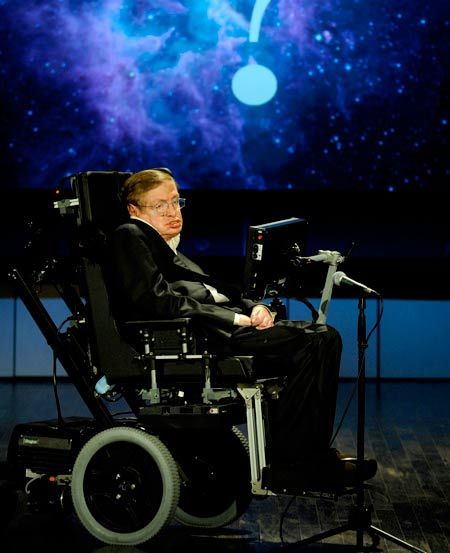New Museum Exhibit Celebrates Famed Physicist Stephen Hawking

A museum exhibition honoring renowned physicist Stephen Hawking, who has defied the odds by living long past what medical experts predicted for someone with the degenerative Lou Gehrig's disease, opened today (Jan. 20) in London.
The exhibition at the Science Museum, London, entitled "Stephen Hawking: A 70th Birthday Celebration," marks the first time items from Hawking's personal archives have been on display.
He and his daughter Lucy helped choose the objects, which include a model of the gravitational pull of a black hole made by Hawking, his drawing of the Hawking radiation mechanism (a result of quantum mechanics that proposes black holes actually glow), the annotated script for his 1999 guest appearance on "The Simpsons," and the blue suit he wore for a zero-gravity flight in 2007 aboard space tourism company Zero Gravity Corporation's Boeing 727. [Photos of Hawking items on display]
"We have been very privileged to explore Professor Hawking's archives, discovering early drafts of his hugely influential scientific papers alongside a rich array of popular material," Alison Boyle, curator of astronomy at the museum, said in a statement. "We hope that the selection we have chosen to display will offer a unique insight into the career of the world's best-known scientist."
Other items on display, which fall into two categories — his scientific work and his public profile — include:
- Handwritten notes on work with Roger Penrose of the duo's 1970s paper on the singularities of space-time
- A selection of awards, including the 2006 Copley Medal, 1989 Prince of Asturias Award and the 2010 Cosmos Award
- Various international editions of his book "A Brief History of Time," in which Hawking explores profound questions about our universe, such as "How did the universe begin?" and "Are there other dimensions in space?"
- A 1978 portrait by English artist David Hockney
The display also features a projection of photographs from his life and career, many previously unseen, as well as audio of a message Hawking recorded for the Science Museum's celebration of his birthday.
A synthesizer that uses a predictive text system controlled by movements of Hawking's cheek muscles allows the famous physicist to "talk." As Hawking's disease further degenerates his motor neurons, degrading his ability to even control his facial muscles, engineers will need to figure out ways to keep his voice in working order, according to New Scientist, which interviewed Hawking's voice technician Sam Blackburn.
Sign up for the Live Science daily newsletter now
Get the world’s most fascinating discoveries delivered straight to your inbox.
A portion of the transcript reads:
It has been a glorious time to be alive and doing research in theoretical physics.
Our picture of the universe has changed a great deal in the last 70 years, and I'm happy if I have made a small contribution. I want to share my inspiration and enthusiasm. There's nothing like the Eureka moment of discovering something that no one knew before.
The world has changed greatly over the past 70 years. Science and technology have had a profound impact on the way we live our daily lives. They will continue to do so.
Jeanna Bryner is managing editor of Scientific American. Previously she was editor in chief of Live Science and, prior to that, an editor at Scholastic's Science World magazine. Bryner has an English degree from Salisbury University, a master's degree in biogeochemistry and environmental sciences from the University of Maryland and a graduate science journalism degree from New York University. She has worked as a biologist in Florida, where she monitored wetlands and did field surveys for endangered species, including the gorgeous Florida Scrub Jay. She also received an ocean sciences journalism fellowship from the Woods Hole Oceanographic Institution. She is a firm believer that science is for everyone and that just about everything can be viewed through the lens of science.










